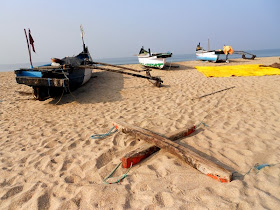Many of us visitors from far and near love visiting Goa, for the people, beaches, shacks, scenes and food.
A significant attraction is the variety of seafood. The humble fishermen in their traditional boats have an effective season of about 7 or 8 months. They brave the winds and rough seas, spending many hours at sea, often in the dead of night, month after month.
I thought I would take a quick look at their boats and related equipment that they use to get us the food that we have come to love. The nets are very fine and complex. Fishermen spend a lot of their 'downtime' fixing boats and nets.
Boats come in several sizes.
A majority of them appear rather frail.
Wonder when the commonly seen design got established. How many centuries or how many thousand years ago was that?
Being protective in nature, the oil extracted from the Cashew plant is commonly used to paint boats.
This boat seems to have dropped anchor in the sand!
Long, early morning shadow of a fishing boat and oars on the fine sand.
The outrigger made of wood and tied up with various types of ropes helps stabilize the little boats.
Well loaded with nets neatly folded, this boat seems ready to set sail any moment.
Formula 1 chequered flag boat, baskets neatly piled up by the side.
Fishermen wash the baskets in the sea.
Another boat, another view.
This is how boats are 'parked'.
Fishing nets laid out to dry, and perhaps repaired before the next trip out.
A little dog appeared suddenly, tail wagging furiously, at the same time barking high pitched and excited, appeared to be a little scared.
That's as far as I wandered, to the village of Velsao, about 4 km from Arossim. Time to head back about 4 km.
According to the map, the beach leads to Bogmalo, a few km away. Need to try that next time! My father-in-law was the Manager of Dabolim Airport during the handover from the Portugese. He said they used to clamber down from the airport down to the sea for a swim. Do you think the reverse may still work? He also has incredible anecdotes to tell us about the simplicity and honesty of the Goan people.
The life guard shelter waits for the life guards to arrive.
Hello, anyone home?
The high tide has left behind interesting sand formations.
On the way back, I see that visitors have arrived by now, towel placed neatly in the shadow of the umbrella.
A beach dog waits for the lifeguard to arrive.
A life guard shows up at about 9:30 AM.
So do a few walkers. The stretch around Cansaulim is very quiet, with about three or four beach shacks.
The little 'cheep-cheep' bird pokes around in the wet sand. They are generally too quick to photograph.
The 'Dolphin Tour' boat seems to have been washed.
The Jet Ski are getting ready for riders to come by.
The water sports crew and life guards share the same shelter.
The beach shacks in the area open up for business by about 9:30 AM.
The menus in shacks and restaurants include the seafood that the hard working fishermen in their hand crafted boats bring for us.
Many fishermen are concerned about the proliferation of large, mechanized, powerful trawlers that don't leave much fish for them. The trawlers can also brave rough seas far better than the little boats can. Faced by severe challenges, the art of fishing in traditional boats may find fewer and fewer takers in future.
Similar views were expressed by fishermen in South Maharashtra, where I traveled to last July.
Thank you for joining me on my little early morning walk around Cansaulim.
Three cheers for the fishermen of Goa (and other states)!
Related Goa posts below:
-=-=-=-=-=-=-=-=-=-=-=-=-=
































No comments:
Post a Comment
Your comments...